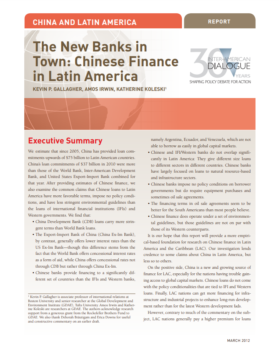
The New Banks in Town: Chinese Finance in Latin America
Estimates of the volume, composition, and characteristics of Chinese lending to the region since 2005.
Crude oil exports from Latin America to the United States have plummeted in recent years as oil production in the region has slumped while demand is on the rise. Meanwhile, competition from Canada is forcing Latin American producers to diversify their exports to Asia. A group of industry experts analyzed these trends in a workshop hosted by the Inter-American Dialogue in cooperation with the Inter-American Development Bank (IDB). The Dialogue’s Lisa Viscidi and Ramón Espinasa of the IDB moderated the exchange.
The US shale boom has led to a decline in light oil imports, but US demand for heavy crude is growing. Latin America’s heavy crude exporters, particularly Mexico and Venezuela, are facing increased competition from Canada, where production of heavy crude from oil sands has increased. In 2004, Canada, Mexico, and Venezuela each exported around 1.3 million barrels per day (b/d) of crude oil to the US. But by 2014, crude imports from Canada had spiked to 2.9 million b/d, while imports from Venezuela and Mexico had fallen by close to 50%.
The Canadian Association of Petroleum Producers projects large increases in unconventional crude production from Western Canada over the next 15 years, and the country plans to add 2.87 million b/d of pipeline capacity to bring crude to US refineries. However, Canadian oil production is particularly vulnerable to price fluctuations, casting doubt over these projections in today’s low oil price environment.
In contrast to Canada, Mexico’s exports have decreased significantly over the past decade. While the US still absorbs the majority of Mexico’s heavy crude exports, the trade balance has steeply declined, with Mexican imports of US refined products increasing almost fourfold in the past 10 years.
Venezuelan exports to the US also dropped significantly to 734,000 b/d last year. However, those volumes are unlikely to drop much further as Venezuela’s oil production remains relatively stable and state oil company PDVSA will want to maximize its crude shipments to its three Citgo refineries in the US, which have a total capacity of 750,000 b/d.
Many Latin American oil exporters are increasingly looking to Asia, where demand is growing and refineries are configured to run heavy crude. Latin American countries, whose oil exports are generally priced off the US benchmark WTI, have an advantage in Asian markets due to the lower price of WTI compared to the global benchmark Brent. To gain market share, Latin American exporters have even been willing to sell to Asian markets when they receive weaker netbacks, or net revenues after discounting the cost of getting the oil to market. Venezuela and Colombia have both found a market in Asia’s biggest heavy crude consumer India, where the embargo against Iran has opened up new market share. Venezuela also exports crude to China as repayment for loans but has decreased those shipments as it prioritizes cash sales to aid its struggling economy.
Findings from the workshop will be incorporated into the Dialogue’s forthcoming working paper on the impact of the US energy boom on Latin American crude oil markets.
Estimates of the volume, composition, and characteristics of Chinese lending to the region since 2005.
Developing scenarios that would lead to another financial crisis is not a fictional exercise; the risk of another crisis is very real.
With crude oil prices down 25 percent since June and holding at roughly $86 a barrel on Tuesday, Venezuela is getting nervous.
 CC BY-SA 2.0
CC BY-SA 2.0
